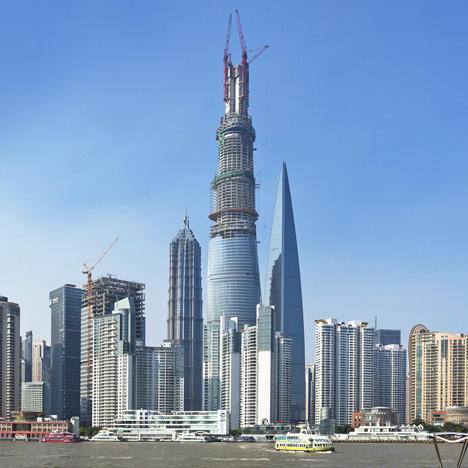World's second-tallest building tops out in Shanghai
News: the topping-out ceremony for the Gensler-designed Shanghai Tower, the world's second-tallest building, takes place in Shanghai tomorrow (Saturday).
The 632 metre-high tower has now reached its full height and is second only to the Burj Khalifa tower in Dubai, which measures 828 metres.
The topping-out ceremony, to be held at the construction site in the Lujiazui development zone in Shanghai, will be attended by Gensler founder Art Gensler and senior figures from the Chinese government.
The twisting form of the tower is the result of wind-tunnel tests and is designed to reduce wind load by 24% during typhoons.
The 121-storey tower will be divided into nine vertical zones, with retail at the bottom and hotels, cultural facilities and observation decks at the top. The zones in between will contain offices.

Shanghai Tower is due to open in 2014. It forms the centrepiece of the emerging Lujiazui high-rise district in Pudong, which is located on a bend of the Huangpu river opposite downtown Shanghai.
The building already towers over neighbouring buildings including the 421 metre-high, pagoda-shaped Jin Mao Tower by SOM, and the 492 metre-high Shanghai World Financial Center by Kohn Pedersen Fox.
Last summer, research by the Council for Tall Buildings and Urban Habitats found that nine of the twenty tallest buildings under construction in the world were in China.
Work briefly started earlier this month on what would be the tallest building on earth - the 838 metre-high Sky City in Changsha in central China, which its developers believe they can build in just seven months. However construction was abruptly postponed due to issues with safety certificates and building permits.
Here's some text about Shanghai Tower from Gensler:
Shanghai Tower will anchor the city’s Lujiazui district, which has emerged as one of East Asia’s leading financial centers. Designed by a local team of Gensler architects to embody Shanghai’s rich culture, the 632-meter-high mixed-use building will complete the city’s super-highrise precinct. It is the most forward-looking of the three towers symbolizing Shanghai’s past, present, and future. The new tower takes inspiration from Shanghai’s tradition of parks and neighborhoods. Its curved façade and spiraling form symbolize the dynamic emergence of modern China. By incorporating sustainable best practices, Shanghai Tower is at the forefront of a new generation of super-highrise towers, achieving the highest level of performance and offering unprecedented community access.
Gensler’s vision for Shanghai Tower has taken tangible form after completion of the immense foundation. Soil conditions in Shanghai—a clay-based mixture typical of a river delta—meant supporting the tower on 831 rein- forced concrete bore piles sunk deep into the ground. For three days, a small army of workers assembled to complete the marathon, 60-hour continuous concrete pour. When the job was finished, more than 61,000 cubic meters of concrete had been used to create the six-meter-thick mat foundation.
The tower’s scale and complexity have created so many “firsts” for China’s construction industry that more than 100 expert panels have been established to analyze every aspect of the design. Workers are busy building forms for the concrete core and erecting the gigantic composite supercolumns—measuring 5 x 4 meters at the base and reinforced with steel plates that weigh 145 metric tons each—that will provide structural support for the tower. To carry the load of the trans- parent glass skin, Gensler designed an innovative curtain wall that is suspended from the mechanical floors above and stabilized by a system of hoop rings and struts. And the strategic division of the tower into nine vertical zones will supply the lifeblood of the building’s heating, cooling, water, and power throughout with less energy and at lower cost.
Gensler won the Shanghai Tower project in an invited multi-stage competition among leading international architects. What secured the win were the tower’s design and performance, and Gensler’s commitment to China. To refine the tower’s shape, Gensler’s team used a series of wind tunnel tests to simulate the region’s greatest natural force, the typhoon. Results produced a structure and shape that reduce wind loads by 24 percent—ultimately yielding a savings of $58 million in construction costs. A simple structure, public spaces within the double façade, and sky gardens based on Shanghai’s traditional open courtyards will make Shanghai Tower an unrivaled asset for the Lujiazui district.